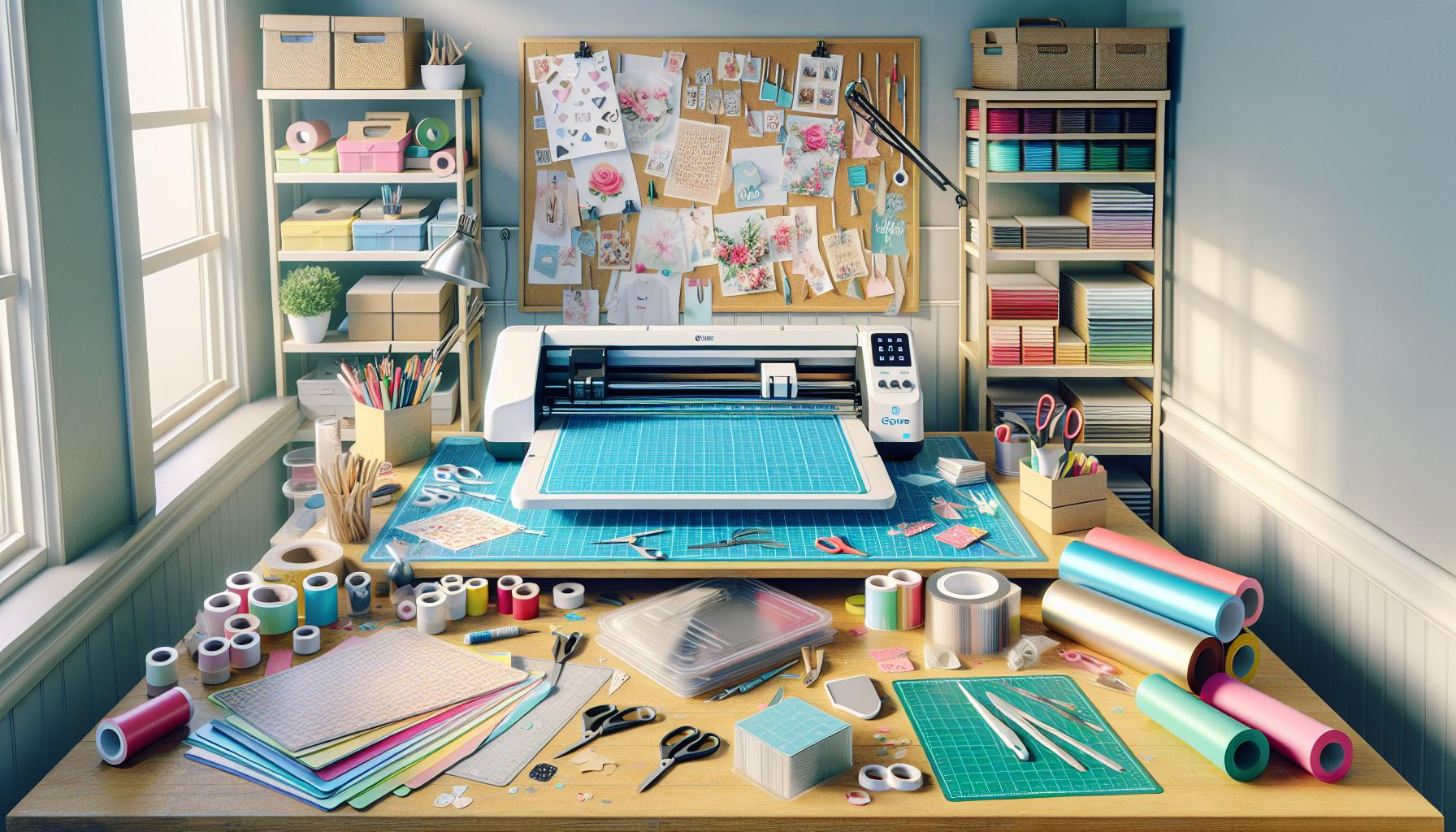If you’re looking to unleash your creativity, DIY Cricut projects might just be your new favorite hobby. These versatile machines open up a world of crafting possibilities, allowing you to design everything from custom home decor to personalized gifts. I’ve found that the satisfaction of creating something unique with my own hands is truly unmatched.
Key Takeaways
- Introduction to DIY Cricut Projects: DIY Cricut projects offer a creative outlet for crafting custom items like home decor, personalized gifts, and party decorations.
- Variety of Projects: Popular projects include home decor items, greeting cards, apparel customization, and unique party decorations, catering to all skill levels.
- Essential Materials: Key materials for Cricut projects include vinyl, heat transfer vinyl, cardstock, chipboard, fabric, and specialty items like foil and glitter.
- Necessary Tools: A Cricut machine, cutting mats, weeding tools, transfer tape, and heat presses or EasyPresses are essential for successful project execution.
- Design and Assembly Tips: Efficient use of Cricut design software and careful cutting and assembly techniques enhance the quality and aesthetics of finished projects.
- Creative Satisfaction: Engaging in DIY Cricut projects fosters a sense of creativity and accomplishment as you create unique, personalized items by hand.
DIY Cricut Projects
DIY Cricut projects encompass a variety of creative applications, allowing me to explore my artistic side. Using Cricut machines, I can design custom items for gifting, decor, or personal expression. The projects range from easy to complex, catering to all skill levels.
Popular DIY Cricut projects include:
- Home Decor Items: I can create wall art, vinyl decals, and personalized signs to enhance my living space.
- Greeting Cards: I design unique cards for occasions like birthdays and holidays, adding a personal touch.
- Apparel Customization: I use heat transfer vinyl to customize T-shirts, tote bags, and other fabric items.
- Party Decorations: I craft banners, table centerpieces, and favors that elevate any celebration.
Each project typically involves easy-to-follow steps. I use design software to create or select designs, cut materials using the Cricut machine, and assemble the final product. The process encourages creativity and satisfaction in crafting something uniquely mine.
Materials Needed for DIY Cricut Projects

Gathering the right materials is crucial for successful DIY Cricut projects. The right supplies enhance creativity and ensure quality results.
Types of Materials
- Vinyl: Adhesive vinyl is great for creating decals and stickers. Oracal 651 is popular for outdoor projects due to its durability.
- Heat Transfer Vinyl (HTV): HTV is essential for apparel projects. Iron-on vinyl adheres easily to fabric when heat is applied.
- Cardstock: Thick cardstock works well for making greeting cards and paper crafts. It comes in various colors and weights.
- Chipboard: Sturdy chipboard creates 3D projects, like mini albums or signs. It adds dimension and durability.
- Fabric: Using fabric for projects requires HTV for effective application. Choose cotton or canvas for best results.
- Foil and Glitter: Specialty materials like foil and glitter add shine to projects. They require specific techniques for adhesion.
- Cricut Machine: Essential for cutting materials accurately. Choose from models like the Cricut Maker or Cricut Explore Air.
- Cutting Mat: A cutting mat provides a sticky surface for material adhesion. Mats come in various grips, suitable for different materials.
- Weeding Tools: These tools simplify removing excess vinyl after cutting. Look for tweezers, hooks, and spatulas for effective weeding.
- Transfer Tape: Transfer tape eases the application of vinyl designs onto surfaces. Choose a light grip for delicate materials.
- Heat Press or EasyPress: For HTV projects, a heat press or EasyPress ensures even heat distribution, allowing for durable applications.
- Scissors and Rulers: Scissors are helpful for precise cuts, while rulers provide straight edges and accurate measurements.
Gathering these materials and tools sets the stage for crafting unique and personalized items with my Cricut machine.
Popular DIY Cricut Projects

Exploring popular DIY Cricut projects showcases the creativity and versatility of the Cricut machine. These projects transform simple materials into stunning, personalized items.
Home Decor
Home decor projects allow me to express my style uniquely. I can create wall art, custom signs, and decorative accents. For instance, personalized canvas prints or vinyl wall decals add character to any space. By selecting a design in the Cricut software, cutting it from adhesive vinyl, and applying it to the desired surface, I transform ordinary walls into extraordinary canvases. Utilizing chipboard for three-dimensional decor elements, like picture frames or seasonal decorations, further enhances my home’s aesthetic.
Personalized Gifts
Creating personalized gifts with Cricut machines adds a special touch to any occasion. Customized items such as engraved cutting boards, etched glassware, or monogrammed tote bags stand out as thoughtful presents. To craft these gifts, I choose the appropriate material, design in the software, and cut using the Cricut. Afterward, I can assemble with precision, ensuring every aspect reflects the receiver’s personality. These handmade gifts not only convey care but also serve as cherished keepsakes.
Party Decorations
Party decorations let me celebrate life’s moments with flair. I craft banners, centerpieces, and custom invitations that elevate any gathering. Using cardstock or vinyl, I create eye-catching designs for birthday parties, weddings, or baby showers. Each Cricut project starts with a unique design in the software, followed by precise cutting. Once assembled, these decorations create a festive atmosphere, transforming any venue into a memorable experience.
Tips for Successful DIY Cricut Projects

Creating successful DIY Cricut projects involves several key techniques. These tips focus on software usage and assembly to enhance the crafting experience.
Software and Design Tips
Using the Cricut design software efficiently boosts project outcomes. Start by selecting appropriate templates for each project. Familiarize yourself with the software’s tools, which include layers, text editing, and shapes. Utilize the ‘attach’ feature to maintain design alignment during cutting. Optimize your design by scaling elements accurately to fit the intended material. Save designs in various formats to ensure compatibility for future projects. Explore online forums and communities for inspiration and custom design downloads that suit specific needs.
Cutting and Assembly Tips
Proper cutting and assembly techniques enhance the quality of finished projects. Begin with a clean cutting mat to ensure optimal adhesion and precision. Use the right blade type for each material; fine-point blades work for most vinyl and cardstock, while deep-point blades suit thicker materials. Employ a test cut to verify the settings for new materials. Pay attention to blade pressure and speed settings, adjusting them based on material thickness. When assembling, gather all components before starting to streamline the process. Use transfer tape carefully to prevent air bubbles while applying decals. For fabric projects, utilize heat presses for even heat distribution during application.
Creative DIY Projects
Embracing DIY Cricut projects has truly transformed the way I express my creativity. Each project offers a chance to craft something special that reflects my personal style. Whether I’m making custom home decor or unique gifts for loved ones, the satisfaction I get from bringing my ideas to life is unmatched.
With the right materials and tools, I can tackle a variety of projects, regardless of my skill level. The versatility of the Cricut machine empowers me to explore endless possibilities. I encourage you to dive into the world of DIY Cricut projects and discover the joy of creating something uniquely yours. Happy crafting!



